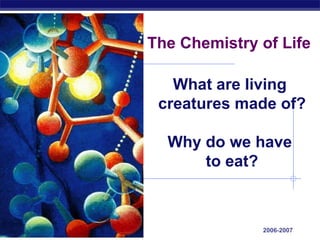02biochemistry
- 1. The Chemistry of Life 2006-2007 What are living creatures made of? Why do we have to eat?
- 2. 96% of living organisms is made of: carbon (C) oxygen (O) hydrogen (H) nitrogen (N) Elements of Life
- 3. Organic vs. Inorganic Organic ï living material that contains carbon (C) Examples: Glucose (C6H12O6) & Starch Inorganic ï Non-living material (no carbon) Examples: Water (H2O) Oxygen (O) Carbon Dioxide (CO2)
- 4. Molecules of Life What are bodies made of? carbohydrates Glucose (simple sugars) ï small Starch ï large Proteins Amino acids fats (lipids) nucleic acids DNA, RNA
- 5. Why do we eat? We eat to take in more of these chemicals Food for building materials to make more of us (cells) for growth for repair Food to make energy calories to make ATP ATP
- 6. What do we need to eat? Foods to give you more building blocks & more energy carbohydrates proteins fats nucleic acids vitamins minerals, salts water
- 7. Water 65% of your body is H 2 O water is inorganic doesnât contain carbon The rest of your body is made of carbon organic = made of carbon & living carbohydrates Proteins ALL of these Fats contain carbon! nucleic acids Donât forget water
- 8. Building large molecules of life Chain together smaller molecules building block molecules Big molecules built from little molecules
- 9. Small molecules = building blocks Bond them together = polymers Building large organic molecules
- 10. How to build large molecules Synthesis building bigger molecules from smaller molecules building cells & bodies repair growth reproduction + ATP
- 11. How to take large molecules apart Hydrolysis ï Digestion ï Break Down taking big molecules apart getting raw materials for synthesis & growth making energy (ATP) for synthesis, growth & everyday functions + ATP
- 12. Example of digestion Starch is digested into glucose (simple sugars) starch glucose ATP ATP ATP ATP ATP ATP ATP
- 13. Example of synthesis amino acids = building block amino acids protein Proteins are synthesized by bonding amino acids
- 14. Any Questions?














